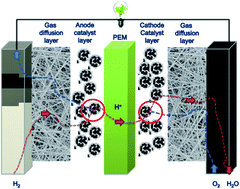Understanding short-side-chain perfluorinated sulfonic acid and its application for high temperature polymer electrolyte membrane fuel cells
Abstract
The great demand for high-temperature operation of polymer electrolyte membrane fuel cells (PEMFCs) has been well answered by short-side-chain perfluorinated sulfonic acid (SSC-PFSA) membranes through a good balance between transport properties and stability. It has been evidenced that fuel cells assembled with SSC-PFSA possess higher and more stable performance at elevated temperature up to 130 °C compared to that of fuel cells based on conventional long-side-chain (LSC) PFSA (Nafion®) membranes. Moreover, the shorter side-pendent chains and the absence of the ether group and of the tertiary carbon also endow SSC-PFSAs with better durability, making them more suitable for working at harsh conditions in fuel cell systems. This critical review is dedicated to summarizing the properties of SSC-PFSA and providing insight into an understanding of their micro-morphologies, mass diffusion, enhanced proton transportation and their mutual correlation. Diversified measurement techniques applied to investigate the evolution of micro-morphologies, unique diffusion and transportation properties of SSC-PFSAs are reviewed. Despite the higher crystalline and higher water absorption of SSC-PFSAs than those of LSC-PFSAs, the notably less developed and less interconnected ionic clusters in SSC-PFSAs lead to lower mass permeability, and hence the high water uptake is not as well translated into transportation performance as expected. The factors and reasons for the enhanced electrochemical performance of SSC-PFSAs such as higher proton conductivity at elevated temperatures and low humidity conditions are also discussed and understood. Highlights of recent advances in SSC-PFSA-based membranes for fuel cell applications at wider temperature ranges are summarized as general references for researchers to further prompt the development of SSC-PFSAs. The SSC-PFSAs based membranes give a bright future for the next generation of high-temperature PEMFCs.

- This article is part of the themed collection: Organic chemistry collection

 Please wait while we load your content...
Please wait while we load your content...